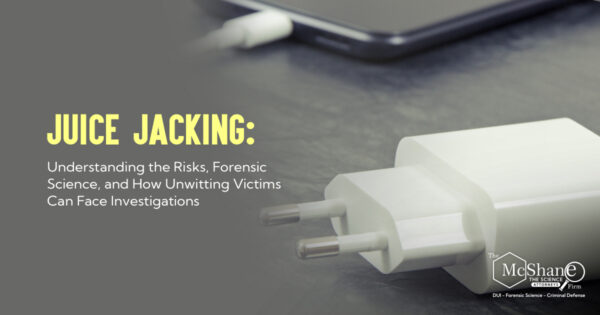Introduction
In today’s technology-driven world, we often rely on public charging stations to keep our devices powered up when on-the-go. However, these convenient charging spots can sometimes become a hotbed for cybercriminal activity, leading to a phenomenon known as “juice jacking.” This blog post aims to provide a comprehensive and technical understanding of juice jacking, the forensic science behind it, and how innocent victims can unknowingly find themselves under investigation due to the unauthorized activities conducted on their devices.
What is Juice Jacking?
Juice jacking is a form of cyberattack where an attacker compromises public charging stations or USB cables, allowing them to gain unauthorized access to a user’s device and steal sensitive data, install malware, or even take control of the device. When a user plugs their device into a compromised charging port or cable, the attacker can potentially access and exploit the device’s data transfer capabilities, leading to potential identity theft, financial loss, or even legal trouble for the unsuspecting victim.
Forensic Science and Juice Jacking
Forensic science plays a critical role in understanding and investigating juice jacking incidents. Digital forensics experts use specialized techniques and tools to analyze devices and identify signs of unauthorized access or data exfiltration. Some of the key steps in a forensic investigation include:
- Device Imaging: Forensic experts create a digital copy of the victim’s device to ensure the integrity of the original data is preserved. This allows them to analyze the device’s contents without the risk of altering or damaging the evidence.
- Malware Analysis: By examining the device’s software and files, digital forensics experts can identify any malware installed by the attacker. This can provide crucial information about the attacker’s methods, motives, and potential targets.
- Log Analysis: Experts scrutinize system logs and other data sources to identify any suspicious activity or unauthorized access attempts that may have occurred during the juice jacking incident.
- Data Recovery: In some cases, attackers may have deleted or modified the victim’s data. Forensic experts can often recover this lost data, providing valuable evidence and helping to restore the victim’s digital assets.
Innocent Victims Under Investigation
One of the most alarming aspects of juice jacking is that innocent victims can find themselves under investigation for illegal activities that they were not aware of. Once an attacker gains access to a victim’s device, they can potentially use it to carry out various criminal activities, such as distributing malware, engaging in identity theft, or participating in cyberattacks.
As these activities are carried out using the victim’s device, law enforcement may trace the illegal actions back to the device owner, leading to a potentially devastating investigation. It is crucial for those who find themselves in this situation to seek expert legal counsel and enlist the help of digital forensics professionals to prove their innocence.
Conclusion
Juice jacking is a growing threat in our increasingly connected world, and understanding the risks, forensic science, and potential legal implications is essential to protect ourselves and our devices. If you suspect that you have been a victim of juice jacking or find yourself under investigation for activities you were not aware of, seeking the help of digital forensics experts and knowledgeable legal counsel is critical to defend your rights and clear your name.


